Learning the past tense is an important step in mastering English grammar. Whether you’re a teacher, parent, or homeschooler, these fun and interactive past tense worksheets will help your children understand and practice this essential skill with confidence.
In this article, you’ll find a variety of free printable worksheets, teaching tips, and example activities perfect for early learners (ages 5-9).
What Is the Past Tense?
The past tense indicates that something has already occurred. In English, we usually add “-ed” to regular verbs to make them past tense. For example:
- Walk → walked.
- Play → played.
- Jump → jumped.
There are also irregular verbs such as
- Go → Went
- Eat → Ate
- Have → Had
Learning to use past-tense verbs correctly helps children explain actions, tell stories, and understand grammar better.
Tips for Teaching Past Tense to Kids
Teaching grammar doesn’t have to be boring! Here are some fun ways to help kids practice the past tense:
- Storytelling: Ask students to tell what they did yesterday.
- Verb Games: Make flashcards and play matching or memory games.
- Worksheet Time: Use printable worksheets to reinforce your writing and comprehension skills.
- Singing Songs: Many children’s songs naturally use the past tense.
Downloadable Past Tense Worksheets
Here are some fun past tense worksheets for your class or homeschooling. Click on the images or buttons below to download and print them.
Worksheet 1: Fill in the Past Tense
- Ages: 6-8
- Activity: Students fill in the blanks with the correct past tense of the given verb.
- Skills: Grammar, Vocabulary, Spelling
- Example: I do—I did
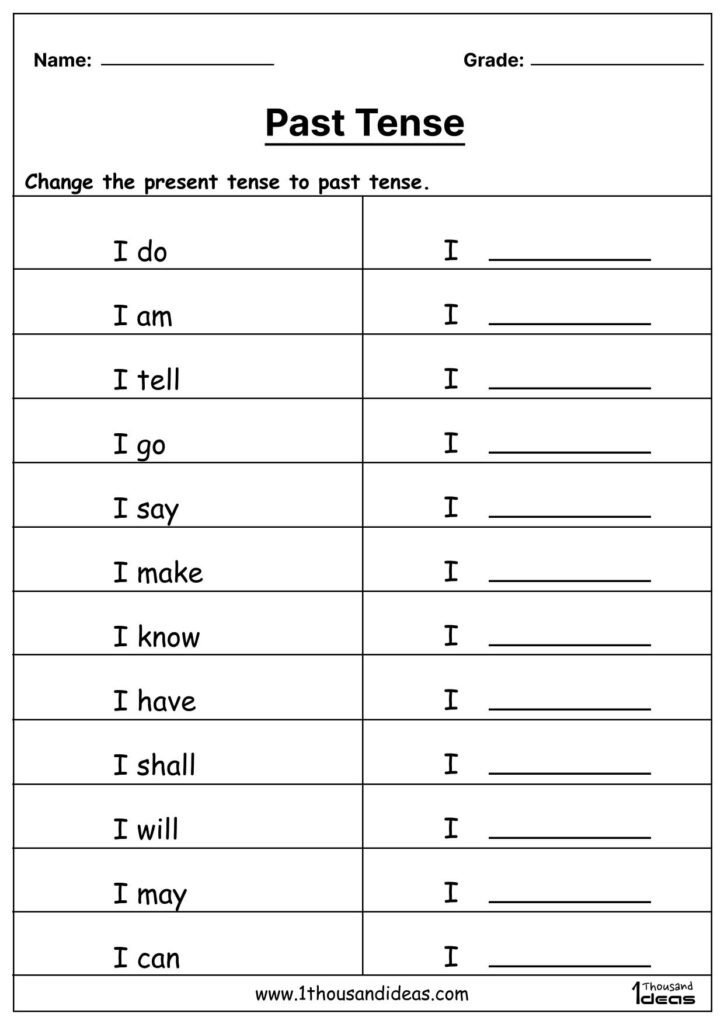
Worksheet 2: What Did You Do Yesterday? (Past Tense Sentences)
- Ages: 7-9
- Activity: Look at the sentence. Fill in the blank with the correct past tense of the verb in the brackets.
- Skills: Personal writing, past tense skills, storytelling
- Example: Today I catch a ball. → Yesterday I _______caught a ball.
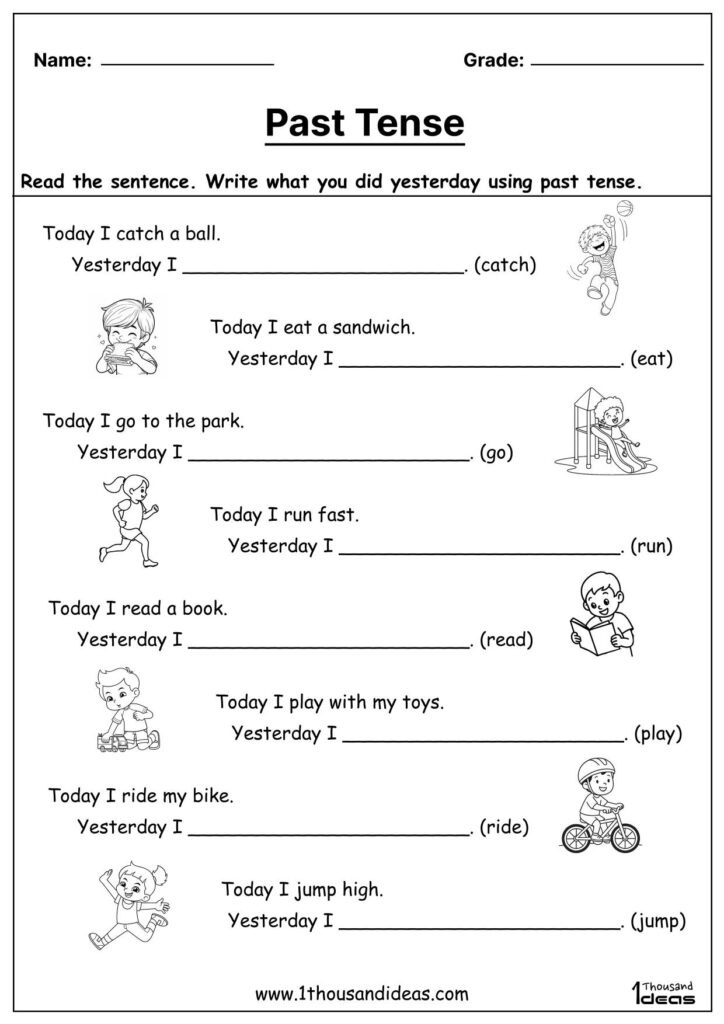
Worksheet 3: Fill in the Blanks Using Past Tense Verbs
- Ages: 6-9
- Activity: Students complete sentences using the past tense verb bank. This worksheet reinforces both the regular and irregular past tenses.
- Skills: Vocabulary, Writing, Grammar Usage
- Example: “I _ (see) a bird in the sky.” → “I saw a bird in the sky.” “She _ bakes a cake.” → “She baked a cake.”
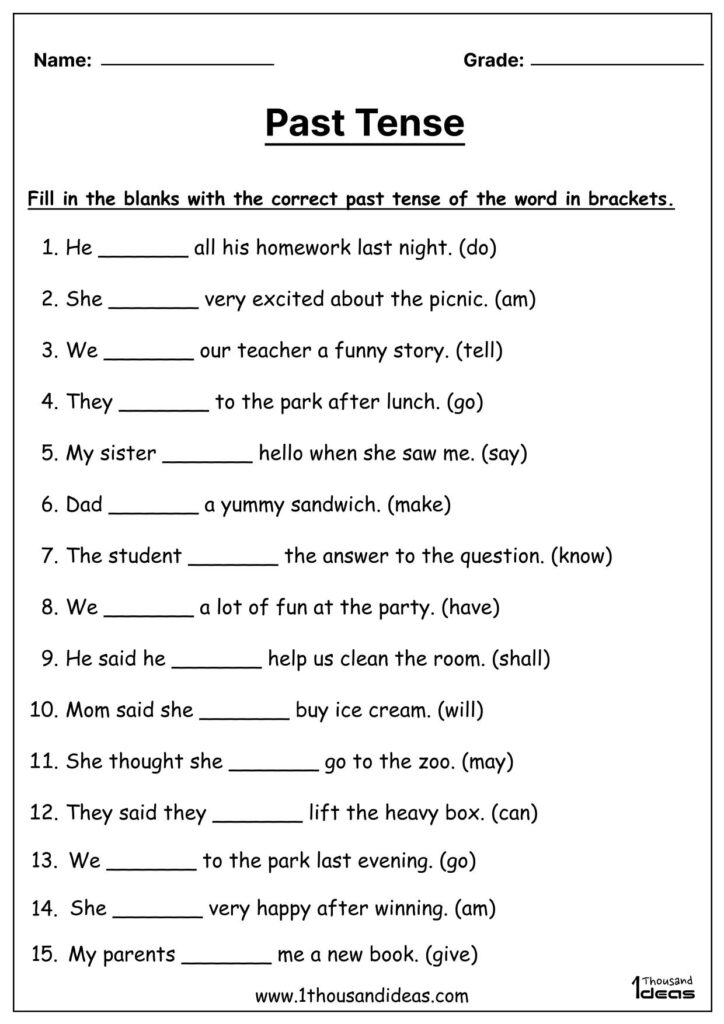
Worksheet 4: Past Tense Verb Match
- Ages: 5–7
- Activity: Match present tense verbs with their past tense forms.
- Skills: Verb recognition, memory
- Example: “eat” → “ate”, “do” → “did”
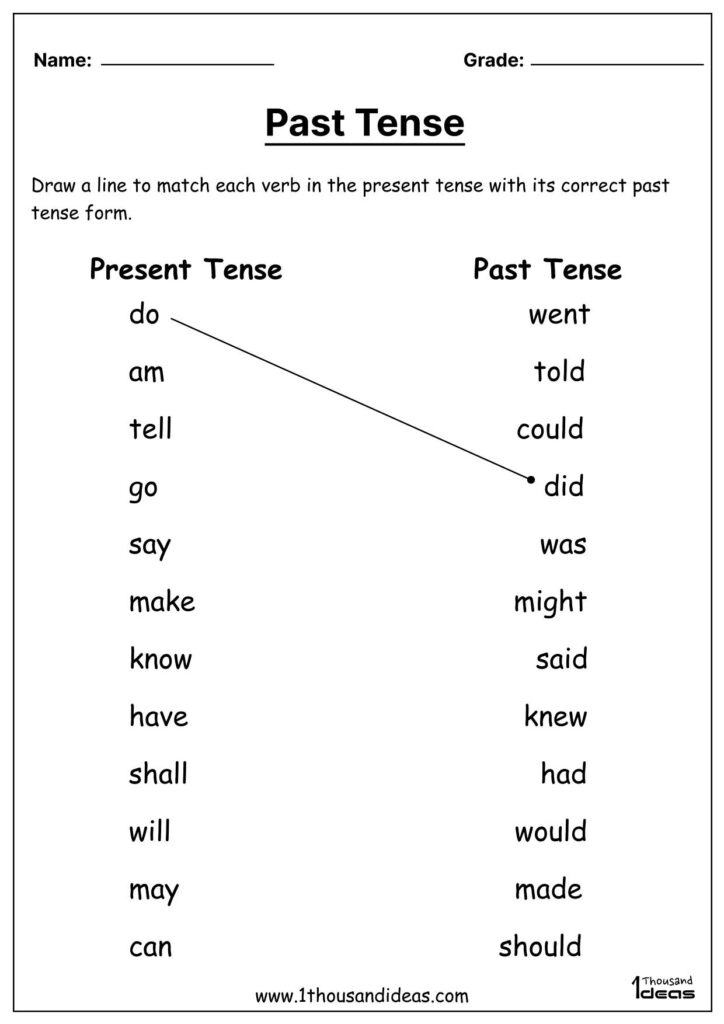
Worksheet 5: Mini Story—Fill in the Past Tense
- Ages: 6-8
- Activity: A short paragraph is given with a missing verb. Students must choose the correct past tense form to complete the story.
- Skills: Reading comprehension, grammar, sentence structure
- Example: Yesterday, Anna (go) to the park. She plays on the swings and eats ice cream.→ Yesterday, Anna went to the park. She played on the swings and ate ice cream.
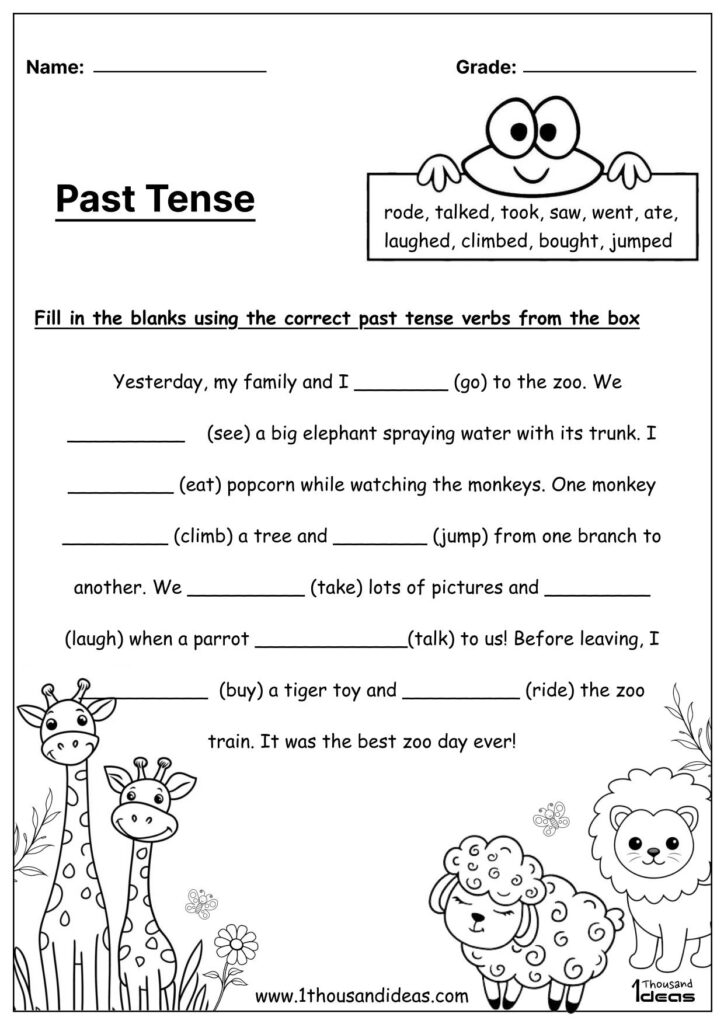
Worksheet 6: Color the Past Tense!
- Ages: 5–7
- Activity: Students identify and color past-tense verbs in a word box. Present tense verbs are colored in blue, and past tense verbs in red.
- Skills: Verb recognition, fine motor skills, grammar basics
- Example: Cooked in red color, walk in blue color.
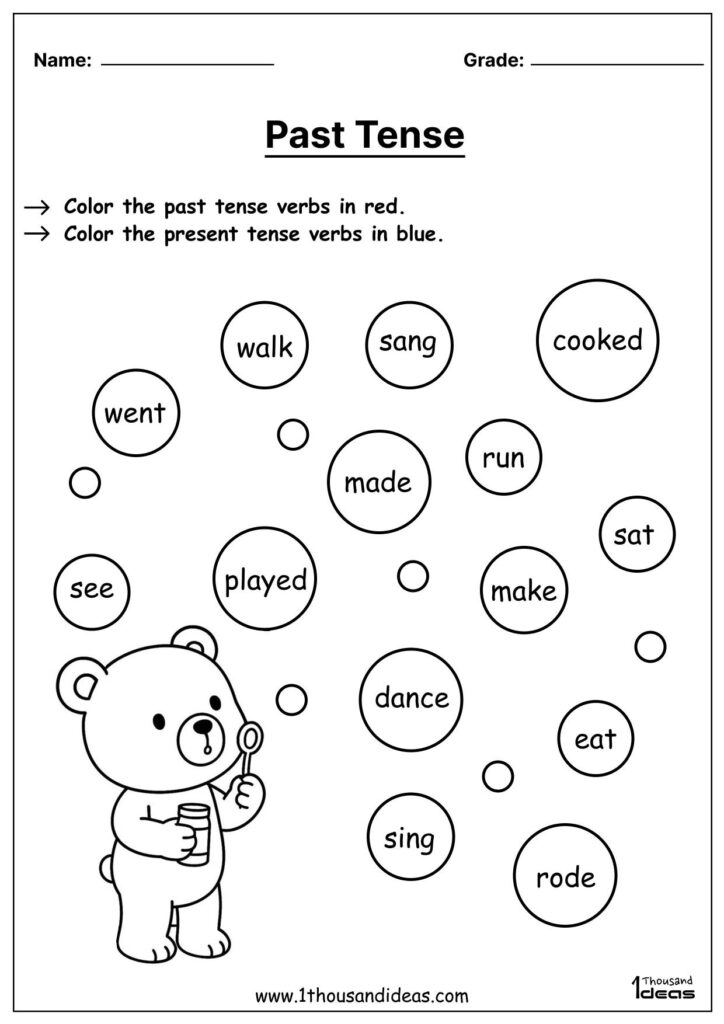
Frequently Asked Questions (FAQ)
1. What is the difference between regular and irregular past-tense verbs?
Regular verbs in the past tense follow a simple rule – just add “-ed” to the base form. For example:
- play → played.
- wash → washed
Intransitive verbs do not follow this rule and have their unique forms. For example:
- go → went
- eat → ate
Teaching both forms with clear examples helps students build confidence and accuracy.
2. At what age should children start learning the past tense?
Most children begin learning about verb tenses between the ages of 5 and 7. Simple worksheets, storytelling, and action-based learning make it easy for young learners to grasp the concept.
3. Can I use these worksheets for online teaching or homeschooling?
Yes! All worksheets are printable PDFs and can be used in virtual lessons, shared in online classrooms, or used at home. You can even turn them into interactive assignments using platforms like Google Slides or Seesaw.
4. How often should children practice past-tense grammar?
A little practice each week goes a long way. Try 2-3 short activities each week, mixing worksheets with conversation games, songs, or drawing exercises to make it fun and effective.
5. What are some fun ways to practice the past tense?
- Practice actions and explain them in the past tense.
- Use picture cards to create “What happened?” Stories
- Ask children to share something they did yesterday or last weekend.
- Play “Past Tense Bingo” or “Verb Charades.”
Final Thoughts
The past tense doesn’t have to be confusing — with the right tools, it can be fun and memorable! Download these free worksheets, print them for your classroom or home, and watch your little learners become more confident in their grammar.


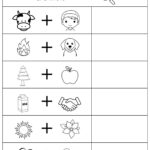

Pingback: Grammar Flip Book for Kids - 1thousandideas
Pingback: Missing Uppercase and Lowercase Letters Worksheets for Kids - 1thousandideas
Keep up the wonderful work, I read few content on this website and I think that your weblog is rattling interesting and has bands of good information.
Thank you so much! Glad you enjoy reading my blog.
Greetings! Very helpful advice on this article! It is the little changes that make the biggest changes. Thanks a lot for sharing!
Thank you for sharing superb informations. Your web-site is very cool. I’m impressed by the details that you have on this web site. It reveals how nicely you understand this subject. Bookmarked this website page, will come back for more articles. You, my pal, ROCK! I found simply the information I already searched everywhere and just couldn’t come across. What an ideal web site.
I’ve been absent for some time, but now I remember why I used to love this website. Thank you, I’ll try and check back more often. How frequently you update your site?
This web site is really a walk-through for all of the info you wanted about this and didn’t know who to ask. Glimpse here, and you’ll definitely discover it.
It’s really a great and useful piece of info. I am glad that you shared this helpful information with us. Please keep us up to date like this. Thanks for sharing.
Well explained
Strongly written
Great line up. We will be linking to this great article on our site. Keep up the good writing.
You have mentioned very interesting points! ps nice internet site. “What a grand thing, to be loved What a grander thing still, to love” by Victor Hugo.
Hello.This article was extremely fascinating, particularly since I was investigating for thoughts on this issue last Tuesday.